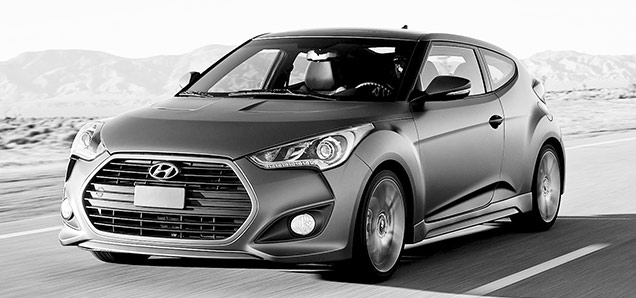Motoring: Comparing the Dart to the Veloster
 CREDIT: HYUNDAI
CREDIT: HYUNDAIThe Hyundai Velostar Turbo has a lot to like, including its eye-catching design.
If you are looking for a small, fun, family car that doesn't cost a fortune, then you should certainly take a closer look at what is being featured here today: the Dodge Dart Rallye and the Hyundai Veloster Turbo.
At first glance, these two don't look like they should compete with each other. After all, one looks like a coupe hatchback, while the other is a more conventional-looking sedan.
Look deeper, however, and things get a little bit more interesting.
Both cars have four-cylinder turbo-charged engines, mated to either a six-speed manual or six-speed dual-clutch gearboxes, driving the front wheels, and both technically have four doors (the Dart is a conventional four-door, and if you count the tail-gate on the Veloster along with its three other doors, it's also a four-door vehicle).
Both are practical, sensible, economical runabouts that are designed to be a little bit more entertaining than a conventional compact vehicle.
Which is best? Read on!
Styling
If it's looks you're after, then the winner here is the Veloster Turbo. While the Dart is an attractive car, especially in Rallye trim, park these two next to each other and most people walking by will look at the Veloster Turbo.
A simple run to the gas station proved this theory. While no one ever came to ask me about the Dart whenever I took it to a gas station, many people came and asked me about the Veloster.
People are just drawn to the Veloster, even if some think it is a bit ugly. It gets the attention because it manages to look like nothing else on the road, and that makes it interesting.
Both the Dart Rallye and the Veloster Turbo come with alloy wheels, and are available is plenty of amusing colours to suit your taste.
Interior
Step inside both, and the first impression is that both vehicles are well made and well equipped.
While the interior of the Veloster looks funkier, I actually preferred the Dart. The Dart has a handsome interior, with just the right amount of youthful touches. While some who got in the Veloster thought it was trying too hard to get attention, everyone liked the compact-luxury car feel of the Dart's interior. So for me, the Dart wins here.
The Dart also wins for its seats. While the Veloster is decently comfortable, the Dart has one of the most comfortable seats I have ever come across on a car in this segment. You can spend all day in these seats — and I did — and you won't get tired. God job, Dodge.
As far as infotainment is concerned, both cars can be had with a touchscreen system that features navigation, satellite radio and much more.
If you are picking between these two and you drive a lot, pick the Dart.
Driving
Now we come to the main bit, which is more fun to drive. The Dart Rallye comes with a 1.4-litre turbo-charged inline four-cylinder motor that produces 160hp and a truly impressive 184lb/ft of torque. This motor can be mated to either a six-speed dual clutch automated transmission or a six-speed manual. My tester had the latter transmission and, apart from its ultralarge shift knob, I found the gearbox to be quite pleasant to use. However, due to its three tiny pedals, heel and toe downshifts are not easy to accomplish with this car.
The Veloster Turbo is equipped with a 1.6-litre turbo-charged inline four-cylinder motor that produces 201hp and 195lb/ft of torque. This model is also available with a six-speed dual clutch automated gearbox or a six-speed manual, and my tester was thankfully equipped with the latter. The Veloster's gearbox is not the slickest in the business, but it ain't bad either.
How do these two translate their power on the road?
Both cars suffer from turbo-lag, which makes them a bit annoying to drive in the city. The Dart Rallye really needed to be encouraged with a heavy foot to cope with city traffic, but the Veloster Turbo was not much better. In fact, the Veloster probably has even more turbo lag.
Both cars also suffer from very tall gearing, which is great for lab tests when recording the best fuel economy numbers, but not very amusing in the real world. Since I'm on the subject of fuel economy, during my week's test, the Dart Rallye managed 8.3 litres/100km, while the Veloster Turbo was slightly behind with 8.5 litres/100km.
Back to the driving feel. Apart from turbo-lag, both cars ride and handle quite well, however, while the Veloster has more grip, the Dart has a better steering feel and offers a much more comfortable ride.
Speaking of ride comfort, the Dart is the most comfortable compact car I have ever driven. Earlier I pointed out that the seats are quite comfortable, but when you combine that with a chassis and suspension setup that just masks all the road's imperfections and couple that with its sound deadening, the Dart is a great highway companion.
Both the Veloster Turbo and the Dart Rallye had enough torque to make overtaking cars on the highway quite effortless, but again, I think the Dart was just a little bit better.
Pricing
The Dodge Dart Rallye is yours from $19,995, while the Veloster Turbo is yours from $26,249. Equip both with the same level of equipment and the price gap is not quite as huge as the base price suggests.
Verdict
Both cars offer a lot to their perspective buyers, and owners of both cars will be reasonably happy with them. Picking one over the other is a matter of personal taste, but for me, the winner of this battle is the Dodge Dart Rallye.













